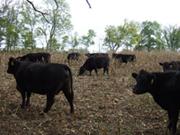Farm Highlight: Buddy Smith
 Buddy Smith owns and manages a beef cattle and hay operation on over 400 acres in Anderson County and does an exemplary job of managing his unique grazing program. A graduate of UK’s Master Grazer, Master Stocker, Master Cattleman, and Advanced Master Cattleman programs, Buddy often participates in grazing schools, field days, and other programs to share his knowledge and experience with others. Buddy raises registered Angus cattle for seedstock as well as marketing some animals as freezer beef. He also produces and sells quality hay. Because of the success of his grazing program, very little stored feed is needed to feed his cattle over the winter. The majority of the hay produced on the farm is sold, which increases overall profitability of the operation.
Buddy Smith owns and manages a beef cattle and hay operation on over 400 acres in Anderson County and does an exemplary job of managing his unique grazing program. A graduate of UK’s Master Grazer, Master Stocker, Master Cattleman, and Advanced Master Cattleman programs, Buddy often participates in grazing schools, field days, and other programs to share his knowledge and experience with others. Buddy raises registered Angus cattle for seedstock as well as marketing some animals as freezer beef. He also produces and sells quality hay. Because of the success of his grazing program, very little stored feed is needed to feed his cattle over the winter. The majority of the hay produced on the farm is sold, which increases overall profitability of the operation.
Like all successful rotational grazing systems, this farm has developed and evolved over the years. The farm started as a beef farm using continuous grazing. In 2006, the farm was selected to be one of the Master Grazer demonstration farms. Cost share money was available for a number of farms across the state to assist in further development of managed grazing systems. These farms were often used for educational programs and demonstrations. Buddy has hosted multiple field days as well as the statewide Kentucky Forage and Grassland Council (KFGC) field day. This aid to this particular farm was to incorporate grazing corn and alfalfa into a rotational grazing system. It was also meant to develop a temporary fence and water system. Over the years, Buddy, along with Anderson County agriculture and natural resource extension agent, Tommy Yankey, have continued to advance his grazing system.
Most producers utilizing a rotational grazing system will emphasize the importance of the water system and the importance of having water available in every paddock. Buddy also believes that developing his water system was what made rotational grazing work for him. Water is available in each of the 15 permanent paddocks using frost-free permanent waterers or temporary waterers with quick couplers and portable tanks. Paddocks are divided as needed and cattle are usually moved every 3-4 days.
One of the most unique aspects of this grazing system is the variety of forages utilized to increase the length of the grazing season. These forages include tall fescue, orchardgrass, red clover, ladino clover, alfalfa, eastern gamagrass, turnips, and corn. Grazing alfalfa, corn, eastern gamagrass, turnips, and stockpiled tall fescue along with the other species has allowed for year-round grazing. Alfalfa is mainly used for hay production but is grazed during drought years using a strip grazing method. Eastern gamagrass, a warm-season perennial, provides excellent hay and summer grazing, while turnips can provide late fall and early spring forage.
Corn is utilized for fall and winter grazing. Buddy began grazing corn in 2006, which has successfully extended his grazing season and has helped him continue to decrease the need for stored feed over time. Strip grazing is used to decrease forage loss and increase utilization. The paddock is divided into small strips (0.5-1 acre) by the use of temporary fence. He has a simple process to divide paddocks which takes very little time. He drives a Gator through corn rows and poly wire is run through tread-in posts to quickly divide the paddocks. This only takes one hour per week for each group of cattle. Grazing management must be altered throughout years as conditions and yields fluctuate. Buddy explained that in December 2008 he put 28 cows onto 10 acres of corn and allowed them 0.5 acres per week. As cows started calving he increased to 0.6 acres. These cows also had 20 acres of stockpiled tall fescue available. Because the corn did not supply adequate protein to the cows post-calving, 0.5 lb of protein was fed every other day. These cows received no hay throughout the year. According to Buddy, the cattle would often spend all day in the corn and other days they would come out and mostly lay in the stockpiled fescue.
Buddy has altered and advanced his grazing program through the years to make it into the successful operation it is. Using a variety of forages along with incorporating water and fencing systems has increased the success of the operation. Since switching to a managed grazing system, pastures are more uniform, and general health of pastures has improved. Rotational grazing has allowed for increased utilization, increased gains per acre, increased the carrying capacity of the land, and increased overall profitability. It has also greatly reduced feeding costs by reducing the need for stored feed.
Categories:
General
Farm Highlights


